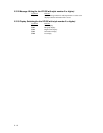
2 - 7
2 RECEIVING FUNCTIONS
2.2.12 Setting the Trip Level
(See Section 4.7.5 of the instruction manual for the VR200.)
Format: SLp1, p2, p3
p1: Trip level number
VR100 and VR200 with style number 1 or lower
1 for level 1 (red line)
2 for level 2 (yellow line)
VR200 with style number 2 higher
1 to 6
p2: Whether to display. Enter “ON” or “OFF.”
p3: Level. 0 to 100 (%).
p4: Color (RED, GRN, BLU, BRN, PRP, L.BLU, ORG, GRY,
W.RED, only for VR200 with style number 2 or higher)
Example:SL1, ON, 70, RED
This example sets the red trip-level line to be displayed at 70%.
2.2.13 Setting the Floppy Disk Format Type (FD, only for VR104/VR202/VR204)
(See Section 5.1 of the instruction manual for the VR200.)
Format: SFp1
p1: “1.44M” for 1.44 MB 2HD
(or “1.2M” for 1.2 MB 2HD only if you use the Japanese version
software with an NEC PC-9801 series PC)
Example:SF1.44M
This example defines that floppy disks will be formatted as 1.44 MB (2HD).
If your model has -3M optioin, the format type of the flopyy disk must be fixed to
1.44MB.
2.2.14 Setting the Data File Name (FILE)
(See Section 5.2 of the instruction manual for the VR200.)
Format: SGp1, p2, p3, p4
p1: Enter the file comment (in up to 32 characters).
p2: Specify the method of setting the file names:
“DATE” for using the names set automatically
“SET” for using the user-defined names
“AUTO” for automatically incrementing the file number.
p3: Name of the event file(s) (up to seven characters). The entry is
invalid when p2 is set to “DATE.”
When p2 is set to “AUTO,” enter the desired three characters for
the second to fourth characters of each file name.
p4: Name of the display data file(s) (up to seven characters). The
entry is invalid when p2 is set to “DATE.”
When p2 is set to “AUTO,” enter the three-digit serial number,
which will be set to the fifth to seventh characters of each file
name.
Example:SG, SET, TANK01, TWAVE01
This example defines “TANK01” and “TWAVE01” as the names of the
event file and display data file, respectively.
For the rules when specifying file names, see Appendix 2.
2.2 Program Set Commands


















